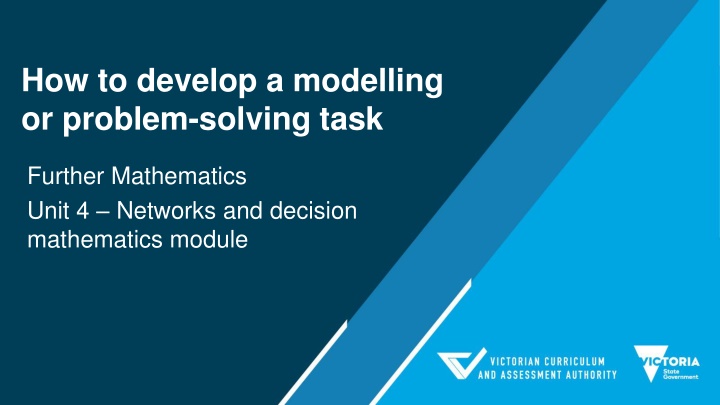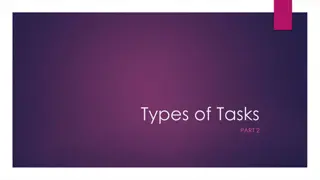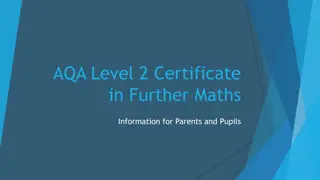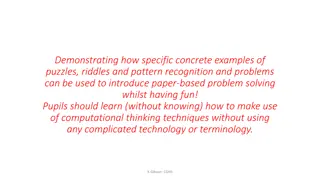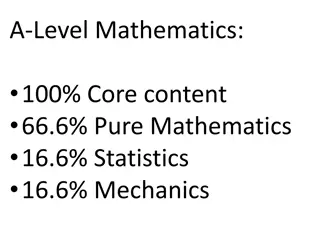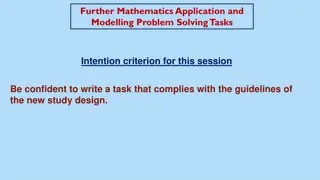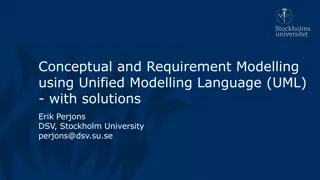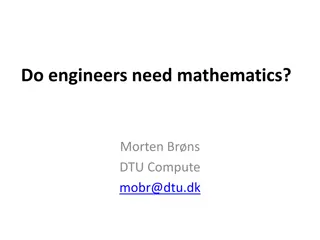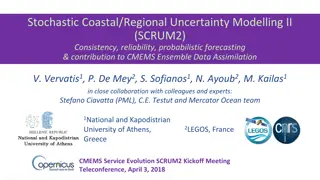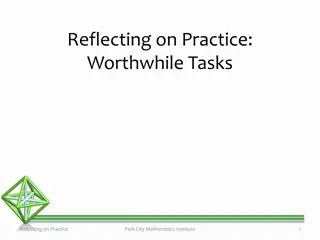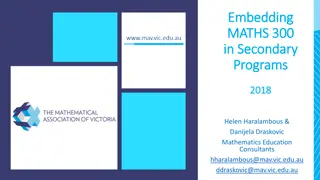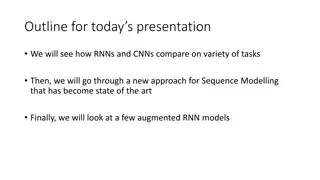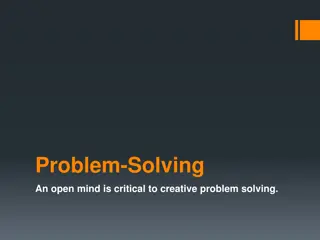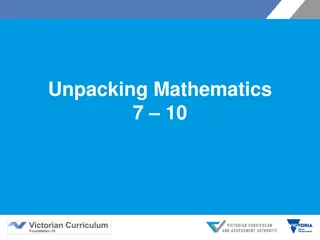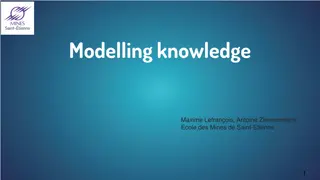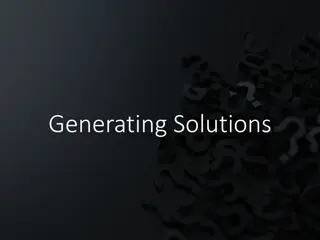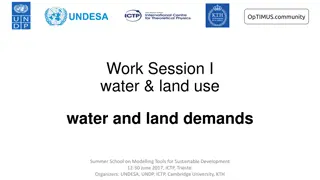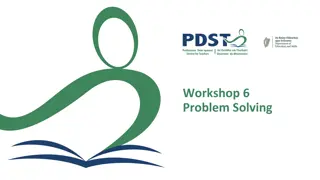Developing Modelling & Problem-Solving Tasks in Further Mathematics Unit 4
This PowerPoint presentation outlines a process for creating modelling or problem-solving tasks in the context of Networks and Decision Mathematics. The purpose, nature, and structure of such tasks are elaborated, along with a framework for mathematical modelling and problem-solving. Learn how to model real-world scenarios effectively and engage in the problem-solving process with clarity.
Download Presentation

Please find below an Image/Link to download the presentation.
The content on the website is provided AS IS for your information and personal use only. It may not be sold, licensed, or shared on other websites without obtaining consent from the author.If you encounter any issues during the download, it is possible that the publisher has removed the file from their server.
You are allowed to download the files provided on this website for personal or commercial use, subject to the condition that they are used lawfully. All files are the property of their respective owners.
The content on the website is provided AS IS for your information and personal use only. It may not be sold, licensed, or shared on other websites without obtaining consent from the author.
E N D
Presentation Transcript
How to develop a modelling or problem-solving task Further Mathematics Unit 4 Networks and decision mathematics module
Introduction This PowerPoint presentation and accompanying set of videos outline a process for developing a modelling or problem- solving task, and illustrate how this can be done using a sample task. It also includes information on the purpose, nature and structure of a modelling or problem-solving task and indicates how a related assessment scheme could be devised.
Purpose of a modelling or problem-solving task Networks and decision mathematics The purpose of this modelling or problem-solving task is for students to model a situation or solve a problem or set of related problems in some depth with respect to a particular context that involves information provided in network diagrams (directed and weighted) and related concepts, skills and processes. This will involve selected content from the topics: graphs and networks, flow problems, shortest path problems applied to modelling or problem-solving in real life contexts, for example situations or scenarios involving: the efficiency of travel between places or accessibility of places in network systems the shortest or longest time taken to reach a specific destination the impact of the direction of travel in navigating an inner-city network.
Modelling and problem-solving Mathematical modelling is a process of using mathematical constructs, structures and techniques to represent and describe a real-world context or system, in a simple and concise way that enables one to investigate features and characteristics of its behaviour; analyse particular aspects or solve problems of interest; and to make predictions related to the context or system. In mathematics, problems are generated from issues, questions, conjectures and hypotheses arising from a range of contexts. New problems may arise in their own right, or as a variation, re-formulation, extension or generalisation of a known problem or class of problems.
A framework for modelling and problem-solving Modelling and problem-solving are complementary processes, the following framework is from the International Mathematical Modeling Challenge (IM2C): https://www.immchallenge.org.au/supporting- resources/mathematical-modelling-framework. Describe the real-world problem. Identify and understand the practical aspects of the situation. Specify the mathematical problem. Frame the real-world scenario as an appropriate, related mathematical question(s). Formulate the mathematical model. Make simplifying assumptions, choose variables, estimate magnitudes of inputs, justify decisions made. Solve the mathematics. Interpret the solution. Consider mathematical results in terms of their real-world meanings. Evaluate the model. Make a judgment as to the adequacy of the solution to the original question(s). Modify the model as necessary and repeat the cycle until an adequate solution has been found. Report the solution. Communicate clearly and fully your suggestions to address the real-world problem.
Nature of the modelling or problem-solving process The following is a simple scheme for the modelling or problem-solving process: Develop mathematical model or formulate problem Real world or theoretical context Apply mathematical model or use problem-solving strategies and techniques Interpret results and refine model or problem and approaches A modelling or problem-solving task is to be of 2 3 hours duration over a continuous period of 1 week.
Structure of a modelling or problem-solving task A task can be developed with several parts that draw on the framework and scheme: Introduction of the context, scenario, situation or problem and familiarisation through simple examples. Further development of a model or problem by generalisation, increased complexity or consideration of variation or special cases. Use of a model for analysis or problem-solving strategies for finding solutions. Evaluation of a model with discussion of limitations, refinement of a problem-solving approach and interpretation of solutions in context.
Developing a task There are four key aspects to developing a modelling or problem-solving task: 1 Choosing the context 2 Identifying questions of interest Relating these questions and relevant concepts, skills and processes to the parts of the task 3 4 Devising the assessment scheme In this case a two part sample task will be developed.
Video 1: Choosing the context and identifying questions of interest Describe the context Explain how the context was chosen (stimulus/background) Identify questions of interest Identify relevant information and source(s) Give the task a title Show the title and overview/background paragraphs
Video 1: Choosing the context and identifying questions of interest Describe the context Analysing the impact of one-way travel in a network of inner-city streets. Explain how the context was chosen (stimulus/background) Visiting a venue in inner Melbourne and noting the difficulty in travelling to the destination along a series of one-way streets.
Video 1: Choosing the context and identifying questions of interest Identify questions of interest Would all venues be accessible for a specific start point in the street network? How does one-way travel impact journeys in larger networks? Is there a street network system where time of travel is efficient and inefficient? How do traffic calming devices impact time of travel?
Video 1: Choosing the context and identifying questions of interest Title One-way travel through streets Overview/background Travelling along a network of one-way streets requires planning and preparation to efficiently reach a destination. Navigating a well populated inner-city precinct consisting of one-way streets requires a good knowledge of the general road network and the direction of travel along each road.
Video 2: Task Part 1 Identify information and source(s) State questions of interest and related analysis Identify relevant content Show written version of Part 1
Video 2: Task Part 1 Identify information and source(s) Researching one-way street networks in small and large settings. Researching traffic calming devices to determine their impact on travel time.
Video 2: Task Part 1 State questions of interest and related analysis How could travel occur around a single city-block if only one-way travel was considered? (analysing one-way networks) If the network precinct was expanded to include more city-blocks, how could one-way travel impact a journey to a destination? (analysing one-way networks) Can bigger city-precinct networks using one-way travel render some areas inaccessible? (analysing one-way networks)
Video 2: Task Part 1 Identify relevant content A review of the concepts, conventions and terminology of graphs including directed (digraphs) and networks. Review of the concepts, conventions and notations of walks, trails, paths, cycles and circuits.
Video 2: Task Part 1: Written version Consider a single rectangular city block surrounded by roads where vehicles are only permitted to travel one-way. a. Draw and describe one journey a vehicle could travel around this block so that each corner could be visited. Expand the precinct to include four connected rectangular city blocks, each surrounded by roads where vehicles can only travel one-way. Consider different configurations of the four rectangles. Some examples might be: b. For several selected configurations, explore different combinations of one-way roads that would make a corner inaccessible. Summarise findings and justify any possible combinations that are found.
Video 2: Task Part 1: Written version c. Explore other networks of city blocks made up of at least nine connected rectangles with each single city block being surrounded by one-way roads. Develop configurations that make some corners inaccessible. Describe and justify any patterns that are found.
Task Part 1: Indicative content Map indicative content by topic and dot point some examples: Topic: Graphs and Networks A review of the concepts, conventions and terminology of graphs including directed (digraphs) and networks.
Video 3: Task Part 2 Identify information and source(s) State questions of interest and related analysis Identify relevant content Show written version of Part 2
Video 3: Task Part 2 Identify information and source(s) (same as Part 1) Researching one-way street networks in small and large settings. Researching traffic calming devices to determine their impact on travel time.
Video 3: Task Part 2 State questions of interest and related analysis What would a directed and weighted network look like if traffic calming devices are incorporated? (constructing a directed and weighted network) Are all destinations accessible using any directed and weighted network? (analysing a directed and weighted network) What would be the shortest/longest time taken to travel to a specified destination from a given starting point? (calculating shortest/longest paths for directed and weighted networks)
Video 3: Task Part 2 Identify relevant content Review of the concepts, conventions and notations of walks, trails, paths, cycles and circuits. Determination of the shortest path between two specified vertices in a graph, digraph or network by inspection.
Video 3: Task Part 2: Written version Traffic calming devices such as reduced speed limits, raised platforms and pinch points control the vehicle capacity on each inner-city road. Consequently, these traffic calming devices influence the time taken to reach a destination. Consider an inner-city network of nine connected rectangular blocks surrounded by roads having one-way travel and weights indicating the time to travel each section, in seconds, like the example which has been started as shown below. Complete the image or construct a new directed and weighted network.
Video 3: Task Part 2: Written version a. Choose a finish (destination) within the network and calculate the shortest time to complete a journey from start to finish. b. Reverse the direction of three roads. Calculate the shortest time to complete a journey from start to finish. Also include a justification of the longest time taken to complete the journey and the relevant path. c. Explore other journeys by changing times and directions along selected sections of road. Include both the shortest and longest times to reach the chosen destination point. Summarise and justify any patterns found. d. Consider other inner-city networks containing more than nine connected rectangular blocks surrounded by roads having one-way travel. Investigate shortest and longest routes as described in previous parts. Discuss and justify any findings.
Task Part 2: Indicative content Map indicative content by topic and dot point some examples: Topic: Shortest path problems Determination of the shortest path between two specified vertices in a graph, digraph or network by inspection.
Video 4: Assessment Use the following table to map mark weightings for the parts of the task with respect to the outcomes. Marking schemes, criteria, rubrics or descriptors can be used to assess student work. Outcome 1 5 Outcome 2 10 Outcome 3 5 Marks Part 1 3 4 1 Part 2 2 6 4
Outcome 1: aspects of the task related to criteria Criterion 1: 0 1 marks Appropriate use of mathematical conventions, symbols and terminology correct use of network notation, directed graphs, vertices, edges. Criterion 2: 0 2 marks Definition and explanation of key concepts defining a specific one-way network structure relevant to an inner-city precinct. Criterion 3: 0 2 marks Accurate use of mathematical skills and techniques correctly constructing a connected network involving nodes and edges.
Outcome 2: aspects of the task related to criteria Criterion 1: 0 2 marks Identification of important information, variables and constraints Criterion 2: 0 4 marks knowing the nodes and edges must connect in the formulation of a network. knowing the weights on edges are linked to times and the direction of travel. Application of mathematical ideas and content from the specified areas of study review of the concepts, conventions and notations of walks, trails, paths, cycles and circuits. Criterion 3: 0 4 marks Analysis and interpretation of results summarising the structure of a one-way street network and determining if all nodes are accessible.
Outcome 3: aspects of the task related to criteria Criterion 1: 0 2 marks Appropriate selection and effective use of technology using technology functionality to effectively and effectively calculate shortest/longest times for travel. Criterion 2: 0 3 marks Application of technology using technology to correctly evaluate shortest/longest times of travel.
Resources A set of sample tasks is provided in the Advice for teachers section of the study website. The task constructed in this video has been included in this set of sample tasks.
